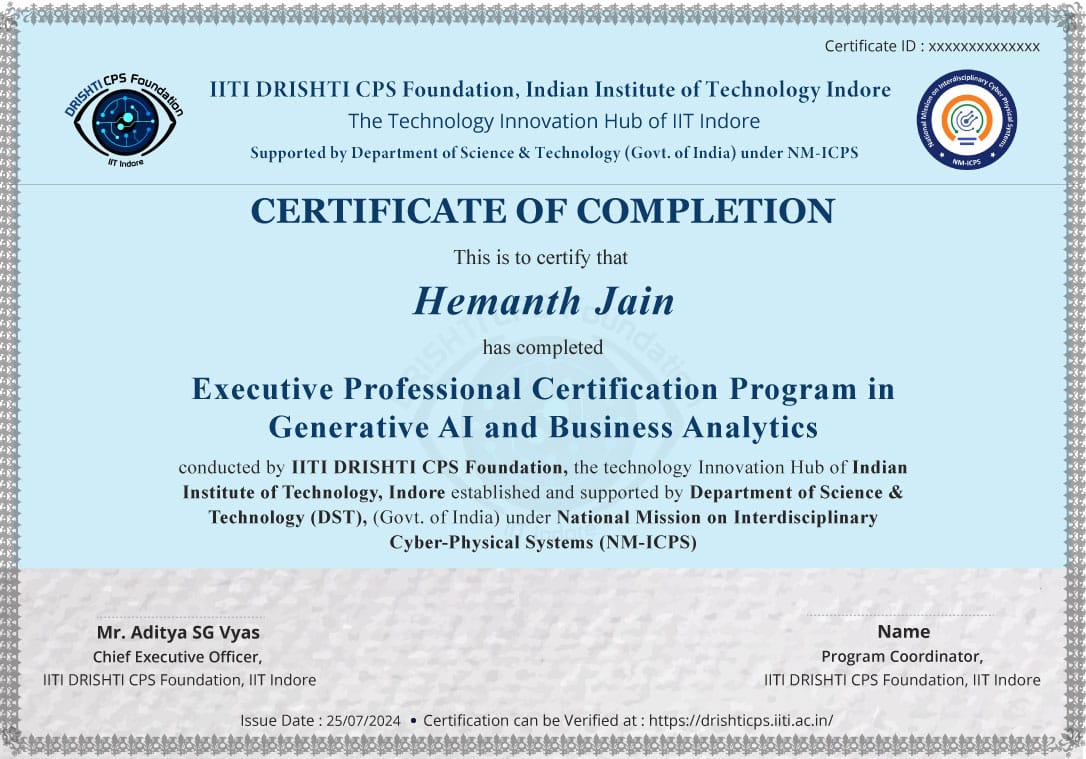Your cart is currently empty.







Unlock your expertise with the Executive Professional Certification Program in Generative AI & Business Analytics in collaboration with IITI DRISHTI CPS, IIT Indore in just 7 months.
Learning Format
Online Bootcamp
Live Classes
7 Months
IIT Indore DRISHTI CPS
Certification
Campus Immersion
IIT Indore
EMI Starts
at ₹8000/month*
This course is curated for learners to enhance their skills in generative AI & business analytics. Work on real world projects & multiple case studies to master the skills of data analysis and business decision making.
About IIT Indore DRISHTI CPS
IIT Indore is the eighth IIT established in 2009 in India. IIT Indore DRISHTI CPS Foundation is a Technology Innovation Hub (TIH) setup at IIT Indore under the aegis of National Mission on Interdisciplinary Cyber-Physical Systems (NM-ICPS) with a focus on System Simulation, Modelling & Visualisation.
Achievements
Skills to Master
Excel Analytics
Data Transformation with SQL
ETL Processes
Python
Mix Market Modeling
Price Optimization Modeling
Generative AI
Prompt Engineering
Statistical Modeling
Predictive Analytics
Risk Analytics
Customer Analytics
BI Reporting
Tools to Master
Learn Fundamentals of Excel
Diving Excel with Data Analytics
Concepts of Data Visualization with Excel
Learning Excel Power Tools
Solving Classification Problems Scenario using Excel
Grasp Information Measure in Excel
Learn Regression Problems Using Excel
Basics of SQL
Learn Advanced SQL
Concepts of User-Defined Functions
Optimization and Performance in SQL
Overview of ETL Testing
Examine Testing for databases and data warehousing
Working with the ETL Testing Scenarios
Dive into Correctness, Completeness, Quality, and Data Validation
Perform Data Checks with SQL
Explore Reports & Cube testing
Getting Started With Python Environment Setup and its Essentials
Break Down the Python Language Basic Constructs
Articulate Object-Oriented Programming Concepts in Python
Establishing Database Connection
Function of NumPy for Mathematical Computing
Working with SciPy for Scientific Computing Tools
Guide of Matplotlib for Data Visualization
Working With Exception Handling
Fundamentals of Machine Learning
Working with Regression
Working with Classification
Working with Clustering
Build and Train with Supervised Learning
Build and Train with Unsupervised Learning
Learn the Basics of Power BI
Overview of DAX
Data Visualization Analytics in Power BI
Fundamentals of Programming in Generative AI
Transformers
BERT
GPT
LLM
Recommendation: Chatbot Powered by Generative AI
Projects are a key component of the Executive Professional Certification Program in Generative AI & Business Analytics, providing you with practical experience to reinforce your knowledge and skills in these cutting-edge areas.

Admission Details
The application process consists of three simple steps. An offer of admission will be made to selected candidates based on the feedback from the interview panel. The selected candidates will be notified over email and phone, and they can block their seats through the payment of the admission fee.
Submit Application
Tell us a bit about yourself and why you want to join this program
Application Review
An admission panel will shortlist candidates based on their application
Admission
Selected candidates will be notified within 1–2 weeks
Total Admission Fee
EMI Starts at
We partnered with financing companies to provide very competitive finance options at 0% interest rate
Financing Partners
![]()
Admissions close once the required number of students is enrolled for the upcoming cohort. Apply early to secure your seat.
| Date | Time | Batch Type | |
|---|---|---|---|
| Program Induction | 4th Jan 2026 | 08:00 PM - 11:00 PM IST | Weekend (Sat-Sun) |
| Regular Classes | 4th Jan 2026 | 08:00 PM - 11:00 PM IST | Weekend (Sat-Sun) |
This Generative AI and Business Analytics Course provides a comprehensive understanding of AI techniques and their application in business analytics. It covers topics like machine learning, data analysis, data visualization, and generative AI models. You’ll gain hands-on experience with tools and techniques, preparing you for roles in data-driven decision-making.
You should take this Courses online because:
This Generative AI & Business Analytics course helps you master the skills required by top employers in the domain of AI & Business Analytics. Latest. You will learn from IIT faculty and top Industry experts . A lot of hands-on projects, assignments and real-world case studies are provided to ensure practical, job-ready skills delivered through this program. Additionally, it includes dedicated career support to maximize job placement opportunities.
You can apply for the following Generative AI & Business Analytics related job profiles:
| Job Role | Average Salary (India) | Average Salary (US) |
| Generative AI Business Analyst | ₹900,000 – ₹1,600,000 | $110,000 – $170,000 |
| Data Scientist | ₹1,200,000 – ₹2,000,000 | $140,000 – $200,000 |
| Business Intelligence Analyst | ₹800,000 – ₹1,400,000 | $90,000 – $150,000 |
| Marketing Analyst | ₹700,000 – ₹1,200,000 | $80,000 – $100,000 |
The course demonstrates how Generative AI can enhance business analytics by providing advanced data generation techniques, improving predictive models, and enabling more sophisticated data analysis.
Yes, the course includes practical examples and case studies to help you understand how generative AI and business analytics are applied in real-world scenarios.
It is not mandatory to have coding or programming skills, but if you have, it will count as a plus point. To make a career in Artificial Intelligence or Business Analytics, you should have strong communication skills, domain knowledge, and an in-depth understanding of Business Analysis tools. A strong forte in aspects of problem-solving is a plus.
Organizations such as Google, Amazon, IBM, Microsoft & many top startups actively recruit professionals specializing in Generative AI and Business Analytics. Additionally, consulting firms like McKinsey, Deloitte, and Accenture, as well as financial institutions like JPMorgan Chase and Goldman Sachs, seek experts in these fields to enhance their data-driven decision-making and innovation capabilities.
Recorded sessions are typically made available for review if you miss a live session. You can watch these recordings at your convenience and catch up on the missed content.
Intellipaat offers query resolution, and you can raise a ticket with the dedicated support team at any time. You can avail yourself of email support for all your queries. We can also arrange one-on-one sessions with our support team if your query is not resolved through email. However, 1:1 session support is given for 6 months from the start date of your course.
Intellipaat provides placement assistance to all learners who have completed the training and moved to the placement pool after clearing the PRT (Placement Readiness Test). More than 500+ top MNCs and startups hire Intellipaat learners. Our alumni work with Google, Microsoft, Amazon, Sony, Ericsson, TCS, Mu Sigma, etc.
What is included in this course?
 Click to Zoom
Click to Zoom
















